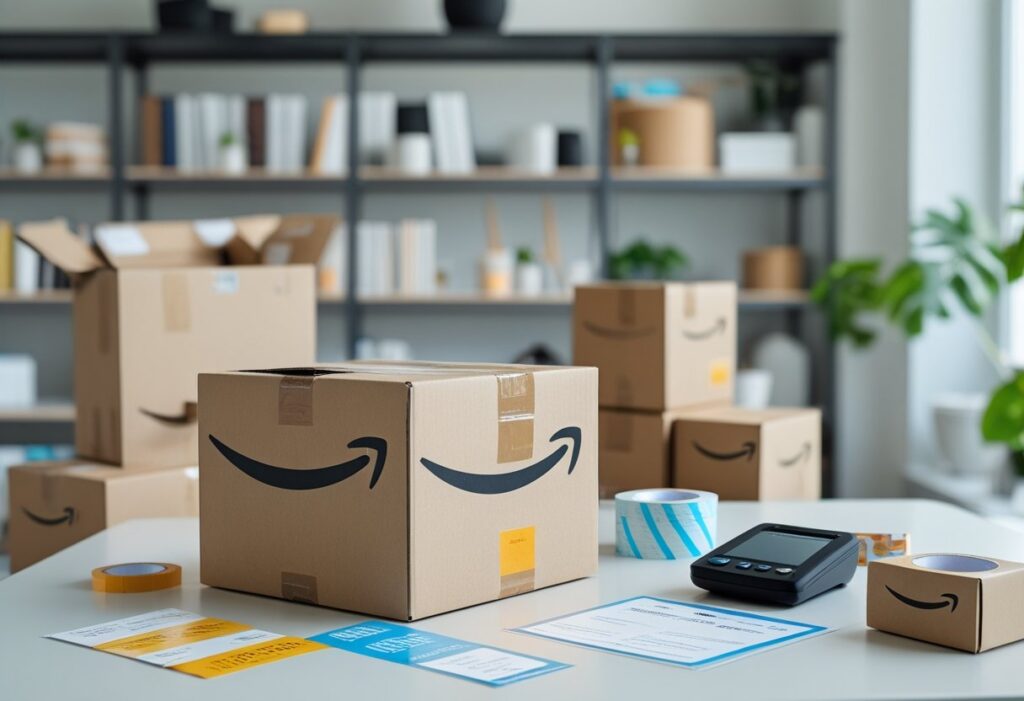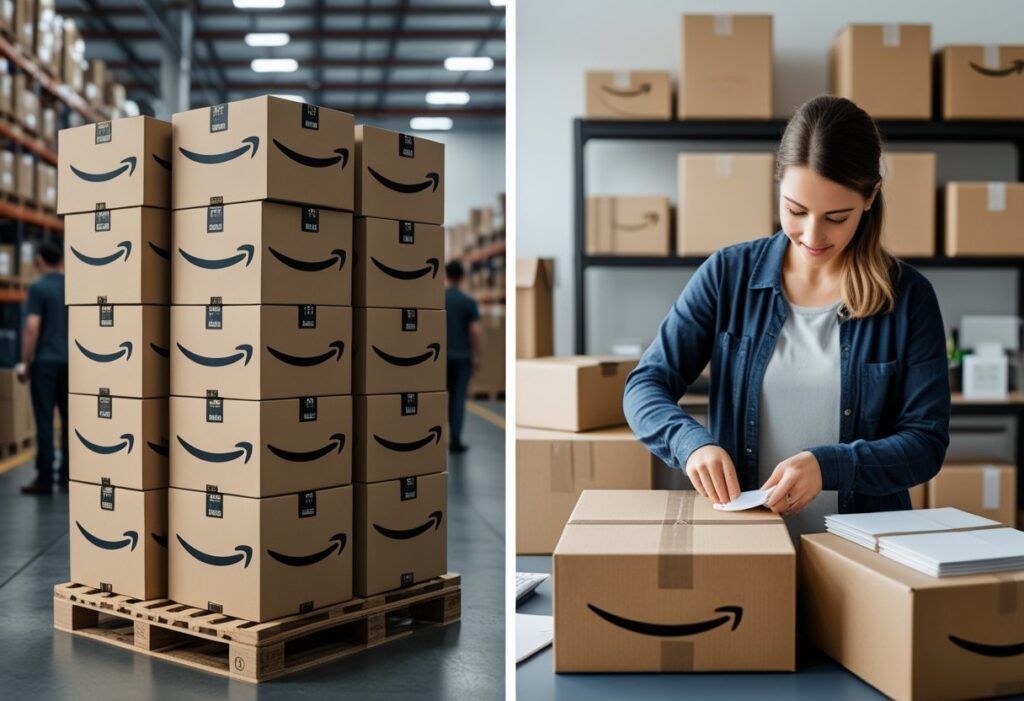When I started selling on Amazon FBA, I quickly learned that small mistakes can turn into expensive lessons. Avoiding even one common error could save you hundreds or even thousands of dollars. Many new Amazon sellers jump in with excitement but skip key steps that protect profits and keep the business running smoothly.

I’ve seen beginners pick the wrong products, overstock inventory, or misprice items, all of which can drain cash fast. Selling on the Amazon marketplace can be a great opportunity, but only if you understand how fees, product demand, and pricing work together. By learning from these common Amazon FBA mistakes, you can skip the trial-and-error phase and start building a more stable business from day one.
The good news is that most of these pitfalls are easy to avoid once you know what to watch for. I’ll share real examples, simple tips, and quick actions you can take right away to protect your investment and grow your sales.
Key Takeaways
- Small mistakes in product choice, pricing, or inventory can quickly eat into profits
- Understanding costs and demand before buying stock reduces financial risk
- Simple daily actions can improve sales and protect your Amazon FBA business
Quick Wins
- Review Amazon FBA fee structure before listing any product
- Check sales rank and recent demand trends for each item you consider selling
- Start with a small test order to avoid tying up too much cash in inventory
Not Understanding Amazon Fees
When I first started selling on Amazon, I was surprised by how many different fees could chip away at my profits. Selling plan fees, referral fees, fulfillment costs, and storage charges can add up quickly if I’m not tracking them closely. Even small miscalculations can turn a profitable product into a loss.
How It Impacts Profit Margins
If I don’t account for all fees before setting my prices, I risk making far less than expected. For example, monthly storage fees increase if my products sit in Amazon’s warehouse too long, and long-term storage fees can be even higher.
Here’s a simple breakdown of common FBA fees:
| Fee Type | When Charged |
|---|---|
| Referral Fee | Each sale, based on product category |
| Fulfillment Fee | Per unit shipped |
| Monthly Storage Fee | Per cubic foot of space used |
| Long-Term Storage Fee | Items stored over 365 days |
I now use Amazon’s Fee Preview tool before launching a product. This helps me see the real costs and adjust my pricing or strategy before I commit.
Quick Wins:
- Use the Fee Preview tool to check costs before listing a product.
- Remove slow-moving inventory to avoid long-term storage fees.
- Choose smaller packaging to lower fulfillment and storage charges.
Poor Product Research
I’ve learned that picking the wrong product can drain time, money, and motivation. Products with low margins, high competition, or weak demand often fail no matter how good the listing looks or how much effort I put into marketing. Careful research before investing is the best way to avoid this trap.
How To Use Tools Like Keepa/SellerAmp
I use Keepa to track price history, sales rank trends, and seasonal patterns. This helps me see if a product sells steadily year-round or only spikes during certain months. I avoid items with unstable pricing or long periods of low sales.
With SellerAmp, I check profit margins after Amazon fees, shipping costs, and prep costs. I also review competition by looking at the number of sellers and their ratings.
I always compare data from both tools before committing. This way, I know the product has healthy demand, stable pricing, and enough room for me to compete without racing to the bottom on price.
Quick Wins:
- Check Keepa charts before buying any inventory.
- Use SellerAmp to confirm at least 30% profit margin.
- Avoid products with more than 20 strong competitors on the listing.
Ignoring Sales Rank

When I overlook a product’s sales rank, I risk choosing items that won’t sell fast enough or will tie up my cash in slow-moving inventory. Tracking this number helps me spot demand trends, compare products, and make smarter buying decisions before I spend money.
Why It Matters And How To Read It
Sales rank shows how well a product is selling in its category compared to others. A lower number means higher sales. For example, a rank of 1,000 in Kitchen might sell daily, while 50,000 could take weeks to move.
I always check rank history using tools like Keepa or Jungle Scout. This tells me if demand is steady or seasonal. I also compare ranks across similar products to see where mine could fit in the market.
Quick Wins:
- Check sales rank history before ordering any product.
- Compare at least 3 competing products’ ranks in the same category.
- Avoid items with high rank spikes that suggest inconsistent sales.
Buying Too Much Inventory Too Soon
When I order more stock than I can sell in a reasonable time, I tie up my cash, pay extra storage fees, and risk having products that never move. Poor forecasting and excitement about a “hot” product can quickly turn into overstocking and wasted resources.
Risks And Better Strategies
Excess inventory eats into profits. Amazon charges long-term storage fees after items sit too long, and those costs add up fast. Products can also become outdated or lose demand, leaving me with unsellable stock.
I’ve learned to start small. I test a product with a limited order, track sales velocity, and reorder based on real data instead of guesses. Using inventory management tools helps me forecast demand more accurately and avoid buying too much too soon.
Quick Wins:
- Order smaller test batches before committing to bulk quantities.
- Set a reorder point based on actual sales data, not just gut feeling.
- Review Amazon’s storage fee schedule so I know the cost of holding extra stock.
Neglecting Condition Guidelines
When I don’t follow Amazon’s product condition rules, I risk more than just unhappy customers. Small mistakes like listing a used item as new or sending damaged packaging can quickly lead to returns, bad reviews, and even account warnings.
How This Causes Returns And Account Issues
If I send an item that arrives with scratches, missing parts, or signs of wear, buyers often request a refund. Many also leave negative feedback, which lowers my seller rating.
Amazon tracks these complaints closely. Too many can trigger account reviews or suspensions. Even “like new” items must be listed under the correct category.
I’ve learned to inspect every unit before shipping and store inventory properly to avoid dust, dents, or moisture damage. Clear, accurate descriptions reduce disputes and keep my account healthy.
Quick Wins:
- Check every product before shipping for damage or missing accessories.
- Use the correct condition category (New, Used – Like New, etc.) every time.
- Read recent customer reviews of similar products to spot common quality complaints and avoid repeating them.
Poor Pricing Strategy
I’ve learned that setting the wrong price can drain profits, hurt sales, and damage buyer trust. If I ignore costs, market trends, or competitor behavior, I risk losing the Buy Box or selling at a loss. A smart pricing strategy balances competitiveness with healthy margins.
Buy Box Competition And Repricing Basics
Winning the Buy Box often comes down to competitive pricing and strong seller metrics. I can’t just slash prices to win—it’s easy to cut too deep and lose profit.
I track competitor prices in real time and watch for price wars. If a competitor is baiting me into lowering my price, I hold firm when my seller rating and fulfillment speed keep me competitive.
Using a repricing tool helps me adjust prices automatically based on stock levels, sales history, and target margins. I make sure the tool supports net-margin pricing so I never sell below cost.
Quick Wins:
- List all costs (FBA fees, shipping, referral fees) and set a minimum price.
- Check top competitors’ prices twice a day for one week.
- Test a repricing rule that changes prices only within your profit margin.
Quick Wins
I focus on small actions that give immediate improvements without needing weeks of work. These steps help me protect my account, improve customer experience, and boost my chances of making sales faster.
3 Things They Can Do Today To Avoid Problems
1. Review My Product Listings
I check my titles, bullet points, and descriptions for clear keywords and benefits. I add at least one high-quality image showing the product in use. Even small updates can improve conversion rates and help my listings rank better in search.
2. Set Up Basic Amazon PPC Campaigns
I start with an automatic campaign at a low daily budget. This puts my product in front of more shoppers and helps me discover which keywords drive clicks. I monitor results after a few days and pause poor performers.
3. Improve Customer Service Response Time
I make sure I reply to all customer messages within 24 hours. Quick, friendly responses improve customer experience and help prevent negative reviews. I also check current orders for any issues so I can fix problems before they escalate.
Conclusion
Selling on Amazon FBA takes patience, planning, and a willingness to adjust when things don’t go as expected. I’ve learned that avoiding common mistakes early can save both money and stress while building a stronger foundation for growth.
Motivation To Keep Learning And Adapting
I remind myself that Amazon changes its rules, algorithms, and competition levels often. What worked last year might not work today.
When I treat my business as a constant learning process, I’m less frustrated by setbacks. I look at mistakes as feedback, not failure.
I make time each week to review my listings, test new keywords, and check my ad performance. Small, steady improvements keep me competitive without feeling overwhelmed.
Quick Wins:
- Read Amazon’s current Terms of Service and note key rules.
- Audit one product listing for better photos and keywords.
- Review inventory levels and adjust reorder plans.
Frequently Asked Questions
I’ve learned that small mistakes in the early days can quickly add up to big problems. Simple changes—like tracking inventory carefully, setting realistic prices, and improving listings—can make a big difference in sales and profit.
What are the top oversights new Amazon FBA sellers should watch out for?
I see beginners skip product research and jump in with items they personally like. This often leads to poor sales.
Another common oversight is ignoring Amazon’s rules, which can get an account suspended. I also notice sellers overstocking, underpricing, or failing to use advertising effectively.
Can you suggest strategies for effective inventory management for FBA beginners?
I keep a close eye on sales trends and reorder before stock runs too low. This helps me avoid losing sales during restocking delays.
I also avoid buying too much at once. Storing excess inventory in Amazon’s warehouses can quickly eat into profits through storage fees.
How can new sellers avoid common pricing pitfalls on Amazon FBA?
I set prices based on both my costs and competitor pricing. Selling too low can make it impossible to cover fees and marketing costs.
I also avoid pricing too high unless my product clearly offers better quality or features. Testing small price changes helps me find the sweet spot.
What are some essential tips for optimizing product listings on Amazon FBA?
I use clear, keyword-rich titles and bullet points that focus on benefits, not just features. High-quality photos showing the product in use make a big difference.
I update my listings regularly. Even small changes—like improved descriptions or better images—can boost conversions.
Could you provide advice on how to handle Amazon FBA fees and reduce costs?
I always factor in all FBA fees before choosing a product. This includes storage, fulfillment, and referral fees.
To reduce costs, I keep my packaging compact, avoid slow-moving products, and only send in inventory I expect to sell within a few months.
What are the best practices for maintaining positive customer feedback as a new Amazon FBA seller?
I respond to messages within 24 hours and fix problems quickly. This shows buyers I care.
I also make sure my product matches its description and arrives in good condition. Consistent quality leads to better reviews without asking for them.
Quick Wins
- Order a small test batch before committing to large inventory purchases.
- Review and update your product listing photos to make them more appealing.
- Check your current pricing against competitors and adjust if needed.


